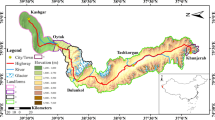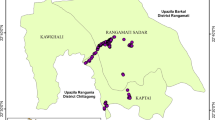Abstract
In this research, the impact of land use and land cover (LULC) on debris flow was evaluated in the Gilgit to Khunjerab region. Two events have been done: (i) LULC stimulations for 2026 and 2030 using the MOLUSCE plugin and (ii) debris flow susceptibility mapping using linear aggression model. The evaluation of LULC on debris flow susceptibility is based on two scenarios: (i) existing (2010, 2014, 2018, 2022) LULC scenarios and (ii) stimulated (2026, 2030) LULC scenarios. The linear aggression model has 16 contributing factors to developing the debris flow susceptibility mapping. The main contributing components in debris flow susceptibility mapping are slope and LCCS. According to the linear aggressiveness model, debris flow susceptibility grows as the LULC changes, and the high susceptibility zones’ share increases. For the current years 2010, 2014, 2018, and 2022, as well as the stimulated years 2026 and 2030, the model had high success rates (> 90.0%) and prediction rates (> 85.0%). The findings backed up prior research and suggested that the impact of LULC will grow in the future.








Similar content being viewed by others
Data availability
Data will be made available on request.
References
Abedin J et al (2017) An investigation of the characteristics, causes, and consequences of June 13, 2017, landslides in Rangamati District Bangladesh. 7(1):1–19
Aditian A, Kubota T, Shinohara YJG (2018) Comparison of GIS-based landslide susceptibility models using frequency ratio, logistic regression, and artificial neural network in a tertiary region of Ambon, Indonesia. 318: p. 101-111
Ahmed BJL (2015) Landslide susceptibility mapping using multi-criteria evaluation techniques in Chittagong Metropolitan Area, Bangladesh. 12(6): p. 1077-1095
Ahmed MF, Rogers JD, Ismail EHJEJoRS (2014) A regional level preliminary landslide susceptibility study of the upper Indus river basin. 47(1): p. 343–373
algorithm, which precision? 2018. 162: p. 177–192
Ali S, Schneiderwind S, Reicherter K (2017) Structural and climatic control of mass movements along the karakoram highway. In Workshop on World Landslide Forum (pp. 509–516). Springer, Cham
Ali S, Biermanns P, Haider R, Reicherter K (2019) Landslide susceptibility mapping by using a geographic information system (GIS) along the China-Pakistan Economic Corridor (Karakoram Highway), Pakistan. Nat Hazard 19(5):999–1022
Anderson JR (1976) A land use and land cover classification system for use with remote sensor data. Vol. 964. US Government Printing Office
Aslam B, Maqsoom A, Khalil U, Ghorbanzadeh O, Blaschke T, Farooq D, ... Ghamisi P (2022) Evaluation of different landslide susceptibility models for a local scale in the Chitral District, Northern Pakistan. Sensors, 22(9), 3107
Bacha AS, Shafique M, van der Werff H (2018) Landslide inventory and susceptibility modelling using geospatial tools, in Hunza-Nagar valley, northern Pakistan. J Mt Sci 15(6):1354–1370
Batar AK, Watanabe TJIIJoG-I (2021) Landslide susceptibility mapping and assessment using geospatial platforms and weights of evidence (WoE) method in the Indian Himalayan Region: recent developments, gaps, and future directions. 10(3): p. 114
Brownlee JJMLM (2019) Understand the impact of learning rate on neural network performance
Buša J et al (2019) Hodnotenie zosuvného hazardu pomocou multivariačnej a bivariačnej štatistickej analýzy v Košickej kotline (Západné Karpaty). 71: p. 383-405
Cao J et al (2020) Multi-geohazards susceptibility mapping based on machine learning—a case study in Jiuzhaigou, China. 102(3): p. 851-871
Chapi K et al (2017) A novel hybrid artificial intelligence approach for flood susceptibility assessment. 95: p. 229-245
Chen W et al (2017) Spatial prediction of landslide susceptibility using an adaptive neuro-fuzzy inference system combined with frequency ratio, generalized additive model, and support vector machine techniques. 297: p. 69–85
Chen Y, Sun J, Lu J (2018) The impact of urban sprawl and industrial structure on environmental pollution. Urban Probl 36:25–37
Chen W et al (2019) Spatial prediction of landslide susceptibility by combining evidential belief function, logistic regression and logistic model tree. 34(11): p. 1177–1201
Ciurleo M, Cascini L, Calvello MJEG (2017) A comparison of statistical and deterministic methods for shallow landslide susceptibility zoning in clayey soils. 223: p. 71-81
Dahal RK et al (2006) Roadside slope failures in Nepal during torrential rainfall and their mitigation. p. 503–514
Fall M, Azzam R, Noubactep CJEg (2006) A multi-method approach to study the stability of natural slopes and landslide susceptibility mapping. 82(4): p. 241–263
Feizizadeh B et al (2014) A GIS-based extended fuzzy multi-criteria evaluation for landslide susceptibility mapping. 73: p. 208-221
Ghorbanzadeh O, Feizizadeh B, Blaschke TJEES (2018) An interval matrix method used to optimize the decision matrix in AHP technique for land subsidence susceptibility mapping. 77(16): p. 1–19
Hasan SS, Sarmin NS, Miah MGJED (2020) Assessment of scenario-based land use changes in the Chittagong Hill Tracts of Bangladesh. 34: p. 100463
Huang P, Peng L, Pan H (2020) Linking the random forests model and GIS to assess geo- hazards risk: a case study in Shifang County, China. IEEE Access 8:28033–28042
IPCC (2014) Climate Change 2014: Synthesis Report. In the Fifth Assessment Report of the Intergovernmental Panel on Climate Change, 1st ed.; Pachauri, R.K., Meyer, L.A., Eds.; IPCC: Geneva, Switzerland
James G et al (2013) An introduction to statistical learning. Vol. 112 Springer
Kamp U, Growley BJ, Khattak GA, Owen LA (2008) GIS-based landslide susceptibility mapping for the 2005 Kashmir earthquake region. Geomorphology 101(4):631–642
Kanwal S et al (2017) GIS based landslide susceptibility mapping of northern areas of Pakistan, a case study of Shigar and Shyok Basins. 8(2): p. 348–366
Khalil U, Imtiaz I, Aslam B, Ullah I, Tariq A, Qin S (2022) Comparative analysis of machine learning and multi-criteria decision making techniques for landslide susceptibility mapping of Muzaffarabad district. Front Environ Sci 10:1–19
Li X, Yeh AG-OJIJoGIS (2002) Neural-network-based cellular automata for simulating multiple land use changes using GIS. 16(4): p. 323–343
Li J, Deng W, Zhang JF, Li SJ, Huang R, Zhang KQ (2016) Problems and countermeasures of water security in southwest mountain resource-based cities under the background of climate change: a case study of Kunming Dongchuan. Mt Res 34:772–779
Liu Y, Fan P, Yue W, Song Y (2020) Impacts of land finance on urban sprawl in China: The case of Chongqing. Land Use Policy 2018, 72, 420–432 mapping in a mountainous area. 10(1): p. 1–14
Maqsoom A et al (2021) Landslide susceptibility mapping along the China Pakistan Economic Corridor (CPEC) route using multi-criteria decision-making method. p. 1–15
Nampak H, Pradhan B, Abd Manap MJJoH (2014) Application of GIS based data driven evidential belief function model to predict groundwater potential zonation. 513: p. 283–300
Neaupane KM, MJEg Piantanakulchai (2006) Analytic network process model for landslide hazard zonation. 85(3–4): p. 281–294
Nicu IC, Asăndulesei AJG (2018) GIS-based evaluation of diagnostic areas in landslide susceptibility analysis of Bahluieț River Basin (Moldavian Plateau, NE Romania). Are Neolithic sites in danger? 314: p. 27–41
Pasang S, Kubíček PJG (2020) Landslide susceptibility mapping using statistical methods along the Asian Highway, Bhutan. 10(11): p. 430
Pourghasemi HR, Rahmati OJC (2018) Prediction of the landslide susceptibility: Which algorithm, which precision?. Catena162: p.177–192
Rabby YW, Li Y, Abedin J, Sabrina S (2022) Impact of land use/land cover change on landslide susceptibility in Rangamati municipality of Rangamati District Bangladesh. ISPRS Intl J Geo-Inform 11(2):89
Raghuvanshi TK, Ibrahim J, Ayalew DJJoAES (2014) Slope stability susceptibility evaluation parameter (SSEP) rating scheme–an approach for landslide hazard zonation. 2014. 99: p. 595–612
Saputra MH, Lee HSJS (2019) Prediction of land use and land cover changes for north sumatra, indonesia, using an artificial-neural-network-based cellular automaton. 11(11): p. 3024
Shi C, Wang YJGF (2021) Non-parametric machine learning methods for interpolation of spatially varying non-stationary and non-Gaussian geotechnical properties. 12(1): p. 339-350
Shou KJ, Lin JFJEg (2016) Multi-scale landslide susceptibility analysis along a mountain highway in Central Taiwan. 212: p. 120–135
Tahir et al (2011) Snow cover dynamics and hydrological regime of the Hunza River basin, Karakoram Range, Northern Pakistan. Hydrol Earth Syst Sci 15(7):2275–2290
Talaei RJJotGSoI (2014) Landslide susceptibility zonation mapping using logistic regression and its validation in Hashtchin Region, northwest of Iran. 84(1): p. 68–86
Tavakkoli Piralilou S et al (2019) Landslide detection using multi-scale image segmentation and different machine learning models in the higher himalayas. 11(21): p. 2575
Ullah I, Aslam B, Shah SHIA, Tariq A, Qin S, Majeed M, Havenith HB (2022) An integrated approach of machine learning, remote sensing, and GIS data for the landslide susceptibility mapping. Land 11(8):1265
Van Westen CJ et al (1997) Prediction of the occurrence of slope instability phenomenal through GIS-based hazard zonation. 86(2): p. 404-414
Vojteková J, Vojtek MJG (2020) Natural hazards, and risk, assessment of landslide susceptibility at a local spatial scale applying the multi-criteria analysis and GIS: a case study from Slovakia. 11(1): p. 131–148
Wang Y, Xiang P (2018) Urban sprawl sustainability of mountainous cities in the context of climate change adaptability using a coupled coordination model: a case study of Chongqing China. Sustainability 11(1):20
Wang Y et al (2020) Comparative study of landslide susceptibility mapping with different recurrent neural networks. 138: p. 104445
Wilde M et al (2018) Pan-European landslide susceptibility mapping: ELSUS Version 2. 14(2): p. 97–104
Yousefi S, Pourghasemi HR, Emami SN, Pouyan S, Eskandari S, Tiefenbacher JP (2020) A machine learning framework for multi-hazards modeling and mapping in a mountainous area. Sci Rep 10(1):1–14
Zhong Z, Chen N, Hu G, Han Z, Ni H (2021) Aggravation of debris flow disaster by extreme climate and engineering: a case study of the Tongzilin Gully, Southwestern Sichuan Province China. Natl Hazards 109(1):237–253
Zhu A-X et al (2019) A similarity-based approach to sampling absence data for landslide susceptibility mapping using data-driven methods. 183: p. 104188
Author information
Authors and Affiliations
Contributions
Conceptualization, A.M. and B.A.; methodology, B.A. and A.M.S.; software, A.M.S. and U.K.; validation, A.M, B.A. and A.M.S.; formal analysis, A.M.S, U.K and B.A.; investigation, B.A. and A.M.S.; data curation, A.M, B.A. and A.M.S.; writing—original draft preparation, B.A. U.K and A.M.S.; writing—review and editing, A.M.S, U.K. and B.A.; visualization, A.M. and B.A.; supervision, A.M.; project administration. All authors have read and agreed to the published version of the manuscript.
Corresponding author
Ethics declarations
Ethics approval
The manuscript does not report on or involve the use of any animal or human data.
Consent to participate
Not applicable.
Consent for publication
Not applicable.
Competing interests
The authors declare no competing interests.
Additional information
Responsible Editor: Philippe Garrigues
Publisher's note
Springer Nature remains neutral with regard to jurisdictional claims in published maps and institutional affiliations.
Rights and permissions
Springer Nature or its licensor (e.g. a society or other partner) holds exclusive rights to this article under a publishing agreement with the author(s) or other rightsholder(s); author self-archiving of the accepted manuscript version of this article is solely governed by the terms of such publishing agreement and applicable law.
About this article
Cite this article
Aslam, B., Maqsoom, A., Saeed, A.M. et al. Impact of LULC on debris flow using linear aggression model from Gilgit to Khunjerab with emphasis on urban sprawl. Environ Sci Pollut Res 30, 107068–107083 (2023). https://doi.org/10.1007/s11356-023-25608-2
Received:
Accepted:
Published:
Issue Date:
DOI: https://doi.org/10.1007/s11356-023-25608-2




